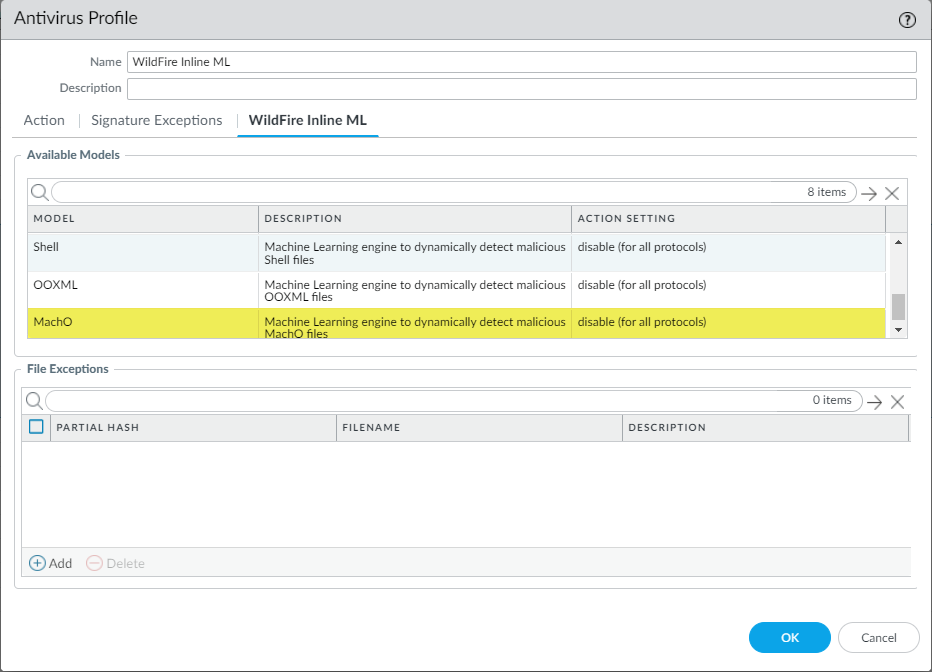Mach-O Support for WildFire Inline ML
Table of Contents
Expand all | Collapse all
-
- Advanced WildFire Support for EML Files
- Advanced WildFire Dashboard Enhancements
- Mach-O Support for WildFire Inline ML
- Advanced WildFire Public Sector Cloud
- Advanced WildFire Government Cloud
- WildFire Spain Cloud
- WildFire Saudi Arabia Cloud
- WildFire Israel Cloud
- WildFire South Africa Cloud
- WildFire South Korea Cloud
- WildFire Qatar Cloud
- WildFire France Cloud
- WildFire Taiwan Cloud
- WildFire Indonesia Cloud
- WildFire Poland Cloud
- WildFire Switzerland Cloud
- Advanced WildFire Support for Intelligent Run-time Memory Analysis
- Shell Script Analysis Support for Wildfire Inline ML
- Standalone WildFire API Subscription
- WildFire India Cloud
- MSI, IQY, and SLK File Analysis
- MS Office Analysis Support for Wildfire Inline ML
- WildFire Germany Cloud
- WildFire Australia Cloud
- Executable and Linked Format (ELF) Analysis Support for WildFire Inline ML
- Global URL Analysis
- WildFire Canada Cloud
- WildFire UK Cloud
- HTML Application and Link File Analysis
- Recursive Analysis
- Perl Script Analysis
- WildFire U.S. Government Cloud
- Real Time WildFire Verdicts and Signatures for PDF and APK Files
- Batch File Analysis
- Real Time WildFire Verdicts and Signatures for PE and ELF Files
- Real Time WildFire Verdicts and Signatures for Documents
- Script Sample Analysis
- ELF Malware Test File
- Email Link Analysis Enhancements
- Sample Removal Request
- Updated WildFire Cloud Data Retention Period
- DEX File Analysis
- Network Traffic Profiling
- Additional Malware Test Files
- Dynamic Unpacking
- Windows 10 Analysis Environment
- Archive (RAR/7z) and ELF File Analysis
- WildFire Analysis of Blocked Files
- WildFire Phishing Verdict
Mach-O Support for WildFire Inline ML
Palo Alto Networks® WildFire® now supports Mach-O format files for WildFire Inline
ML.
To access the new Mach-O file analysis classification engine for WildFire Inline ML, be sure to
download and install the latest content release package. Applications and Threat
content release 8885-8930 running on PAN-OS 11.1 and later allows NGFWs
operating on supported platforms to detect and prevent malicious Mach-O files
from entering your network in real-time using Inline ML. For more information
about the update, refer to the Applications and Threat Content Release
Notes.
To download the release notes, log in to the Palo Alto Networks Support Portal,
click Dynamic Updates and select the release notes listed under Apps +
Threats.
Palo Alto Networks® WildFire® now supports a new executable format
for binaries files for analysis using the WildFire Inline ML classification engine:
Mach-O. This enables you to configure your NGFW to detect and prevent malicious
Mach-O files from entering your network in real-time by applying machine learning
(ML) analytics. WildFire Inline ML dynamically detects
malicious files of specific types by evaluating various file details to formulate a
high probability classification of a file. This protection extends to currently
unknown as well as future variants of threats which match characteristics that Palo
Alto Networks identifies as malicious. To take advantage of WildFire inline ML, you
must have an active WildFire subscription. If you do not have WildFire Inline ML
enabled on your firewall, refer to WildFire Inline ML for more
information.
- Update your existing Antivirus Security profile to enable the Mach-O real-time WildFire analysis classification engine.
- Select an existing Antivirus Profile or Add a new one (Objects > Security Profiles > Antivirus).
- Configure your Antivirus profile.
- Select WildFire Inline ML and apply an Action Setting for the new WildFire inline ML model. This enforces WildFire inline ML Actions settings for each protocol on a per-model basis. In addition to the currently available classification engines, Mach-O should now be available. If this model is unavailable, verify that you have content release 8885-8930 or later installed on the firewall.
![]()
- enable (inherit per-protocol actions)—WildFire inspects traffic according to your selections in the WildFire Inline ML Action column in the decoders section of the Action tab.
- alert-only (override more strict actions to alert)—WildFire inspects traffic according to your selections in the WildFire Inline ML Action column in the decoders section of the Action tab and overrides any action with a severity level higher than alert (drop, reset-client, reset-server, reset-both) alert, which allows traffic to pass while still generating and saving an alert in the threat logs.
- disable (for all protocols)—WildFire allows traffic to pass without any policy action.
- Click OK to exit the Antivirus Profile configuration dialog and Commit your new settings.
(Optional) Add file exceptions to your Antivirus Security profile if you encounter false-positives. This is typically done for users who are not forwarding files to WildFire for analysis. You can add the file exception details directly to the exception list or by specifying a file from the threat logs.(Optional) See Configure WildFire Inline ML for information about testing your firewall’s connection to the inline ML cloud service and viewing related logs.

